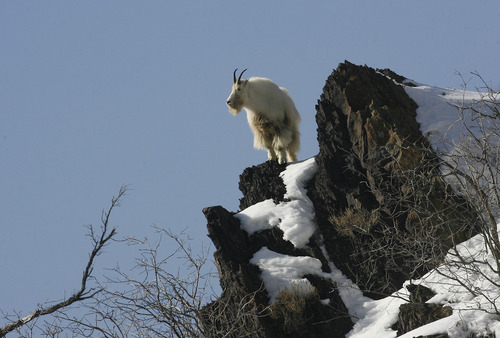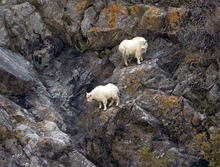This is an archived article that was published on sltrib.com in 2013, and information in the article may be outdated. It is provided only for personal research purposes and may not be reprinted.
Rocky Mountain goats have never roamed Utah's La Sal Mountains.
Still, state wildlife officials, bent on establishing goats there, will not delay this week's planned transplant — despite a request from the U.S. Forest Service, the agency responsible for managing this small island range rising from the desert canyon country around Moab.
The project might benefit trophy hunters, but only at the expense of a fragile alpine ecosystem that has been specifically protected for scientific study, environmentalists and the Forest Service itself say. Now, critics contend the agency is failing its land-management obligations by not intervening in a project that violates the Manti-La Sal National Forest management plan.
"They are ceding decision-making to a state board whose constituency is hunting," said Mary O'Brien, Utah forest program manager with the Grand Canyon Trust. "They are saying they aren't responsible for habitat. If that's how the system has been fixed, it needs to be changed."
At the last minute, the Forest Service announced its opposition to the Utah Division of Wildlife Resource's La Sals plan, saying wild goats could harm rare plant communities and the 2,380-acre Mount Peale Research Natural Area, as well as violate Forest Service policies.
The research area surrounding Peale's 12,721-foot summit at the south end of the range was designated to protect "ecosystem structure and function in alpine and subalpine habitats." Introducing goats now would defeat that purpose and prevent biologists from gathering baseline data that would help determine what impacts the goats would have on various sensitive plant species, Nora Rasure, the Intermountain regional forester, said in an Aug. 22 letter read to the Wildlife Board before it approved the plan in a 4-2 vote later that day.
The La Sals' high country is home to 10 rare plant species that grow nowhere else in Utah, including the La Sal daisy, an imperiled flower endemic to these mountains. These sensitive species are already stressed from climate change and drought, wrote the Ogden-based forester, who oversees Utah's five national forests and others in Idaho, Nevada and Wyoming.
Rasure repeated these concerns Wednesday in a conversation with Mike Styler, director of Utah's Department of Natural Resources. He assured her the state will continue to work in partnership with the Forest Service, but the relocation of 20 goats from the Tushar Mountains will go forward Wednesday.
"This is only one out of 100 issues we share. I look at this as a sibling squabble," Styler said. "We have worked with the Forest Service for years on [goat introductions]. They helped us write the plan for the La Sals. We're a little puzzled why all of the sudden there is an outcry, especially where the goats will be collared and watched very, very carefully."
He noted officials can easily remove the goats, which are to be released on the range's north end, far from Mount Peale.
A Forest Service spokeswoman said her agency's options are limited because wildlife management is the state's purview.
"This is not the outcome we wanted. DWR listened to the concerns of the Forest Service, and we will work jointly on the development of adaptive management strategies to ensure protection of the research natural area and sensitive species in the La Sals," Erin O'Connor said. "The release of 20 goats at the north end will give us time to identify thresholds that indicate unacceptable impacts due to the presence of mountain goats and strategies to deal with those impacts."
Still, several Utah environmental groups contend the Forest Service not only holds the authority to regulate goat introductions, but also has a legal duty to keep goats out of Mount Peale's research natural area, which officials decided long ago should be kept in its natural state.
"If I did this, I would be fined and arrested. It is an illegal use and occupancy," said Kevin Mueller of the Utah Environmental Congress. "We may unfortunately have to take legal action against the Forest Service, although the state is the bad actor here."
At the very least, the goat project should require a special-use permit and a monitoring plan with firm triggers that would evict the goats if certain thresholds are breached, said Wild Utah Project.
bmaffly@sltrib.com Mountain goats in the La Sal Mountains
Rocky Mountain goats are not native to Utah, which is now home to several populations introduced by the state Division of Wildlife Resources. Now DWR plans to put goats into the La Sal Mountains — despite objections from the U.S. Forest Service that the move would harm a fragile alpine tundra and violate national forest policies. DWR says the small range can sustain 200 goats and intends to relocate 20 goats from the Tushars this week.





